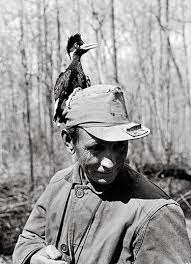The Ivory Billed Woodpecker was the largest species of woodpecker in the United States. For size, it was second only to the Imperial Woodpecker from Mexico, which went extinct in 1962. The ivory billed woodpecker gets its name from the ivory color of its bill, which is different from other species, like the common pileated woodpecker. People often mistake the two. Besides its size of 20 inches, the easiest way to distinguish it from a distance is by its white striped wings when in flight. (see diagram below)
The ivory billed woodpecker favored the large growth forest of the southern United States. This is where the parents would raise their chicks in a hole in a tree. The male and female look similar, but the male's crest was red, whereas the female's was black.
The call of the ivory billed woodpecker was also unique. It's distinct kent, kent call had been recorded in the 1930's and and example of that can be found below.
This bird's love of old growth forest's and reclusive nature, was what began its demise. As the American logging industry started cutting down the old growth forests that the woodpeckers called home, their numbers began declining. Even though some trees were left standing for the birds, they relocated whenever people moved into an area.
In 2004, an ornithologist (bird scientist) claimed to have rediscovered the ivory billed woodpecker. In 2005, scientists flocked to the swamps of Arkansas to look for "the Holy Grail" of recently extinct species. It made world news. The ivory bill got its own stuffed animal and many books were written celebrating this amazing "Lazarus species" (an animal the scientists thought was extinct, but later rediscovered). Though many scientists spent month in the swamps no concrete evidence of these birds was found. There is still a $50,000 reward to this day for anyone who can provide evidence of a living ivory billed woodpecker.
James Tanner and J.J. Kuhn studied some the last remaining ivory billed woodpeckers in the late 1930's. "Sonny Boy" was what Mr. Tanner named the young ivory billed woodpecker he removed from its nest to be banned for study. A few weeks later Mr. Tanner watch Sonny Boy leave the nest and observed him over the next several years. James Tanner tried to get the government to protect that Singer Tract (named after the sewing company) section of Louisiana protected, but it was too late to save the species. Though sightings still continue, the last proof of a living ivory billed woodpecker was made in 1944, marking its believed extinction.
Additional resources:
Stuffed animal by Wild Republic to celebrate the possible sighting of an ivory billed woodpecker in 2008
















Comments
Post a Comment